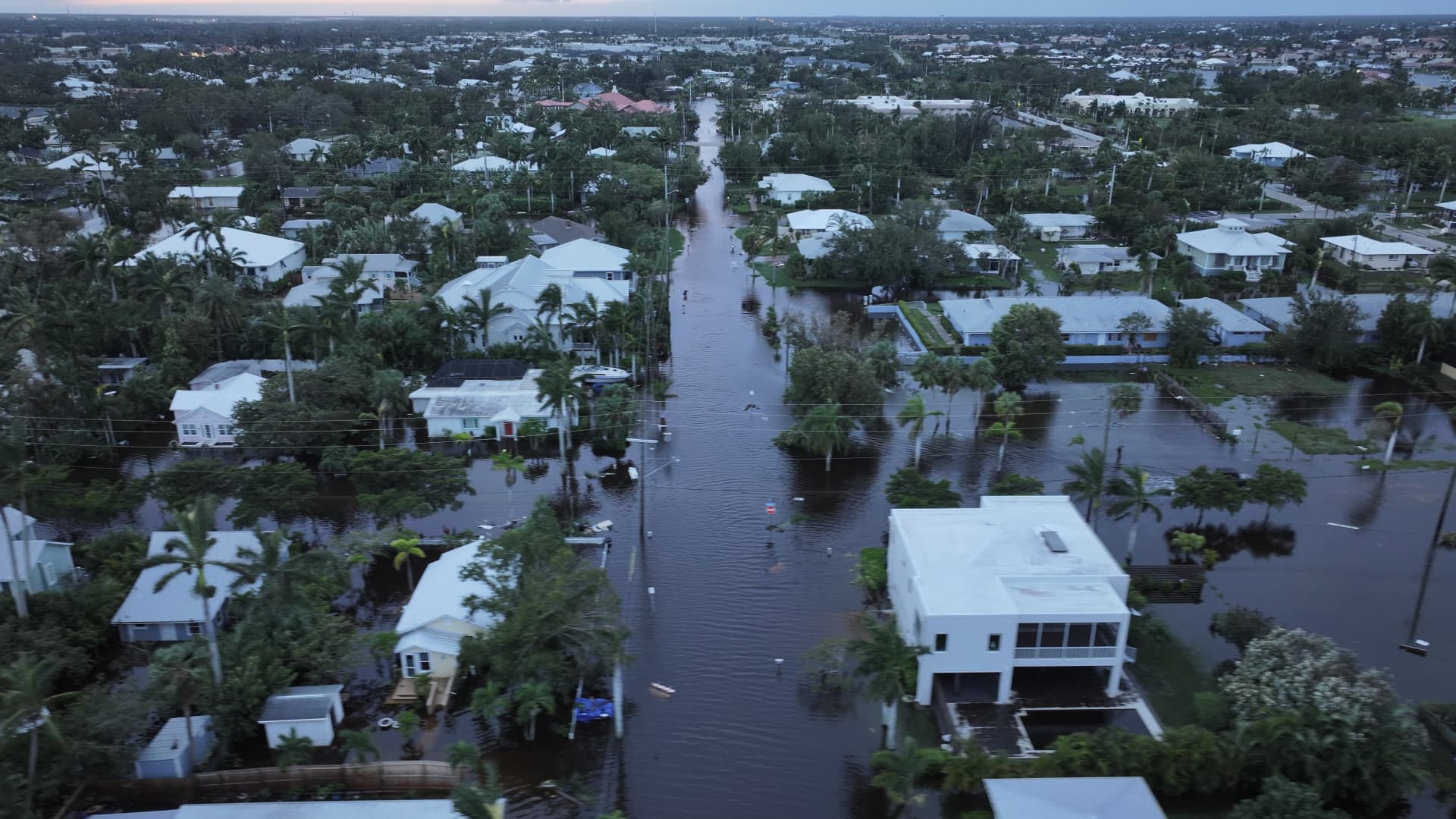Dayna and Matt Fancher lost their home in Fort Myers Beach, Florida, to Hurricane Ian in 2022.
One month into this year’s hurricane season, the couple is still paying their home insurance policy — now twice as costly — while fighting the firm in court over their claim.
The Fanchers, who have lived in their Fort Myers Beach home for almost three decades, said their home insurance provider paid them only a third of what it would cost to rebuild their home, and that adjusters repeatedly disputed their storm damage claims. In the end, the Fanchers say, they took out construction loans to be able to move back into their home.
“We have the same coverage that we had, we’re paying double, and we didn’t get the assistance that we needed,” Matt Fancher said.
The Fanchers’ predicament is just one of many linked to the insurance crisis in hurricane-prone Florida. Rates are sky-high and expected to continue rising as catastrophe claims surge and Floridians face few insurance options and increased scrutiny during underwriting.
Since 2021, Florida has experienced four major hurricanes: Ian, Helene, Idalia and Milton, and premiums have climbed by nearly 30% statewide. Florida residents can now expect to pay almost $10,000 a year on average in premiums, making the state the most expensive place in the U.S. to buy homeowners insurance.
In Fort Myers Beach, a small town on narrow Estero Island off Fort Myers, annual premiums jumped from about $9,000 to almost $14,000 from 2019 to 2024, according to data obtained by First Street Foundation, a climate risk modeling firm.
In the wake of Hurricane Ian, Floridians filed more than half a million residential catastrophe claims, according to Florida’s Office of Insurance Regulation. Up against an estimated $50 billion to $65 billion in insurance losses associated with Hurricane Ian, several homegrown Florida property insurers were declared insolvent, while major national insurers like Farmers announced they would pull back or no longer offer coverage in the state due to increased hurricane risk.
Some legislative reforms have helped stabilize the market for insurance in Florida, according to Mark Friedlander, a spokesperson for the Insurance Information Institute, an industry association for insurers. He said in 2024, the state saw the lowest average statewide premium increases in the country for home insurance and that more than a dozen new insurers had entered the market there.
But hurricane risk in Florida is escalating as human-caused climate change warms the atmosphere and raises sea surface temperatures in the Gulf of Mexico. Hotter conditions are trapping moisture and fueling hurricane intensification, creating wetter, more powerful hurricanes that leave Florida increasingly vulnerable to storm damage. During Hurricane Helene, moisture trapped in the warming atmosphere increased extreme rainfall by 10%, bringing rainfall totals as high as 26.95 inches in parts of Florida.
Jeremy Porter, a climate risk expert at First Street Foundation, says that rising insurance costs signal the deep impacts of climate change in west Florida, as communities like Fort Myers Beach grapple with recurring damage and costly recoveries.
“Over the last few decades, we haven’t kept up with climate risk and quantified it properly in our risk modeling. Now, we’re playing catch-up and it’s driving up insurance rates very rapidly, and people are feeling that in their household budgets,” Porter said.
With scarce options for home insurance, more and more Floridians have started buying insurance from Citizens Insurance Property Corp., Florida’s not-for-profit state-backed insurer, and Porter says this rapid movement has also pushed up insurance costs.
By 2055, Porter says home insurance premiums could rise by 213% in the Tampa metro area because of hurricane risk. Climate risks are also disrupting insurance markets in other parts of the country. In Sacramento, California, residents may face a 137% increase due to increased wildfire danger, for example.
Porter said declining home prices in Florida could also affect home insurance rates and availability. When property values fall in places that are vulnerable to hurricanes or other extreme weather, insurers may interpret that decline as a warning sign of growing physical or market risk, leading to increased scrutiny during underwriting and potential spikes in premiums.
According to Zillow data, home values in Fort Myers Beach are down about $200,000 from their pre-Ian prices, and about 86% of sales over the last year came in under list price, a general sign that sellers are having a difficult time offloading their properties.
At its peak before Hurricane Ian, the average home value on Sanibel Island, a popular spot in Lee County for beach vacationers, was almost $1.3 million. Today, that value is $868,000, with 93% of all homes being sold under list price, according to Zillow.
Joanne Klempner, who has lived part time in Fort Myers Beach since 2016, says that selling her home is not a financially viable option after spending so much on reconstruction post-Hurricane Ian. With little choice but to stay in Fort Myers Beach, Klempner said she worries about how climate change will affect the future of her community.
“At this point, we’re in for the long haul because we have to be. I think whether people want to continue to invest in Fort Myers Beach is the bigger question,” Klempner said. “When you don’t have a hurricane for 30 years, the risk feels worth it to live in paradise. When you have three bad hurricanes within 18 months, it becomes questionable.”
Jacki Liszak, the president and CEO of the Fort Myers Beach Chamber of Commerce, says that Fort Myers Beach is still a great place to live and visit, and that the community is investing in resilient architecture and building homes well above the flood line.
“The houses have to be built strong and they have to be built high,” Liszak said. “I think that will help tremendously. People were already starting to come, and I think they will continue to come. People love this lifestyle. It’s a beautiful part of the world.”





